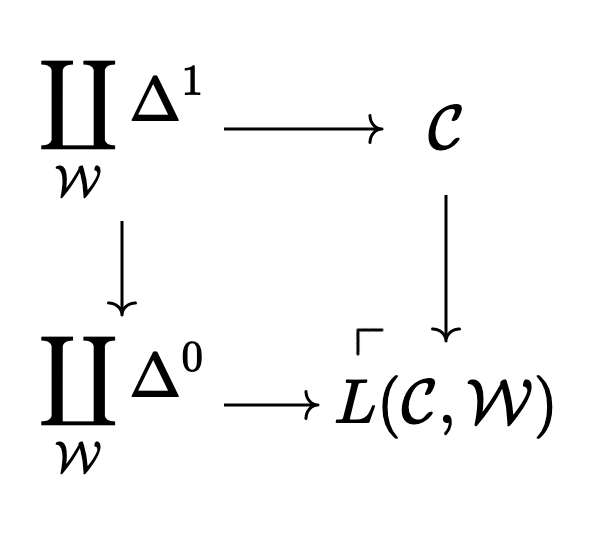Why Care about the "Homotopy Theory of Homotopy Theories"? (Homotopy Theories pt 4/4)
11 Jul 2022 - Tags: homotopy-theories
It’s time for the last post of the series! Ironically, this is the post that
I meant to write from the start. But as I realized how much background
knowledge I needed to provide (and also internalize myself), various sections
got long enough to warrant their own posts.
Well, three posts and around
Let’s get to it!
Let’s take a second to recap what we’ve been talking about over the course of these posts.
We started with relative categories. These are categories
In the first post, we defined the localization (or the homotopy category)
Unfortunately, homotopy categories (to use a technical term)
suck. So we introduce model structures on
Unfortunately again, model categories have problems of their own. While they’re great tools for computation, they don’t have the kinds of nice “formal properties” that we would like. Most disturbingly, there’s no good notion of a functor between two model categories.
We tackled this problem by defining simplicial categories, which are
categories that have a space worth of arrows between any two objects,
rather than just a set. We call simplicial categories
(up to equivalence)
Now, we know how to associate to each relative category
Also, in the previous post we gave a second definition of
To start, recall that we might want to consider two relative categories “the same” if they present the same homotopy theory. With our new, more subtle tool, that’s asking if
but wait… There’s an obvious category
Then this category has objects which are morally isomorphic (since they have equivalent hammock localizations), but which are not actually isomorphic…
Are you thinking what I’m thinking!?
We can do the same thing with simplicial categories (resp. quasicategories)
to get a relative category of
This makes precise the idea that relative categories and
In fact, there’s a zoo of relative categories which all have the
same homotopy category as
If you remember earlier, we only gave a tentative definition of a homotopy theory. Well now we’re in a place to give a proper definition!
A Homotopy Theory
(equivalently, an
Perhaps unsurprisingly, we can do the same simplicial localization
maneuver to one of these relative categories
in order to get an
But why care about all this?
It tells us that (in the abstract) we can make computations with either simplicial categories or quasicategories – whichever is more convenient for the task at hand. But are there any more concrete reasons to care?
Remember all those words ago in the first post of this series, I mentioned that hammock localization works, but feels somewhat unmotivated. Foreshadowing with about as much grace as a young fanfiction author, I asked if there were some more conceptual way to understand the hammock construction, which shows us “what’s really going on”.
Well what’s the simplest example of a localization? Think of the category
Inverting this arrow gives us a category with two objects and an isomorphism
between them, but of course this is equivalent to the terminal category
So then how should we invert all of the arrows in

Here the top functor sends each copy of
For more about this, I really can’t recommend the youtube series
Higher Algebra by Homotopy Theory Münster highly enough.
Their goal is to give the viewer an idea of how we compute with
Personally, that’s exactly what I’m looking for when I’m first learning a topic, and I really appreciated their clarity and insight!
With that last example, we’re finally done! This is easily the most involved (series of) posts I’ve ever written, so thanks for sticking through it!
I learned a ton about model categories and
Stay safe, all, and I’ll see you soon!
-
Note, however, that while most examples of two model categories with the same homotopy theory come from quillen equivalences, this does not have to be the case. See here for an example. ↩
-
When I was originally conceiving of this post, I wanted this to be the punchline.
The “homotopy theory of homotopy theories” is obviously cool, but it wasn’t clear to me what it actually did. I was initially writing up this post in order to explain that I’ve found a new reason to care about heavy duty machinery: Even if it doesn’t directly solve problems, it can allow us to make certain analogies precise, which we can maybe only see from a high-abstraction vantage point.
Fortunately for me, but unfortunately for my original outline for this post, while writing this I’ve found lots of other, more direct, reasons to care about this theory! So I’ve relegated this original plan to the footnote you’re reading… right. now. ↩
-
See Juila Bergner’s A Survey of